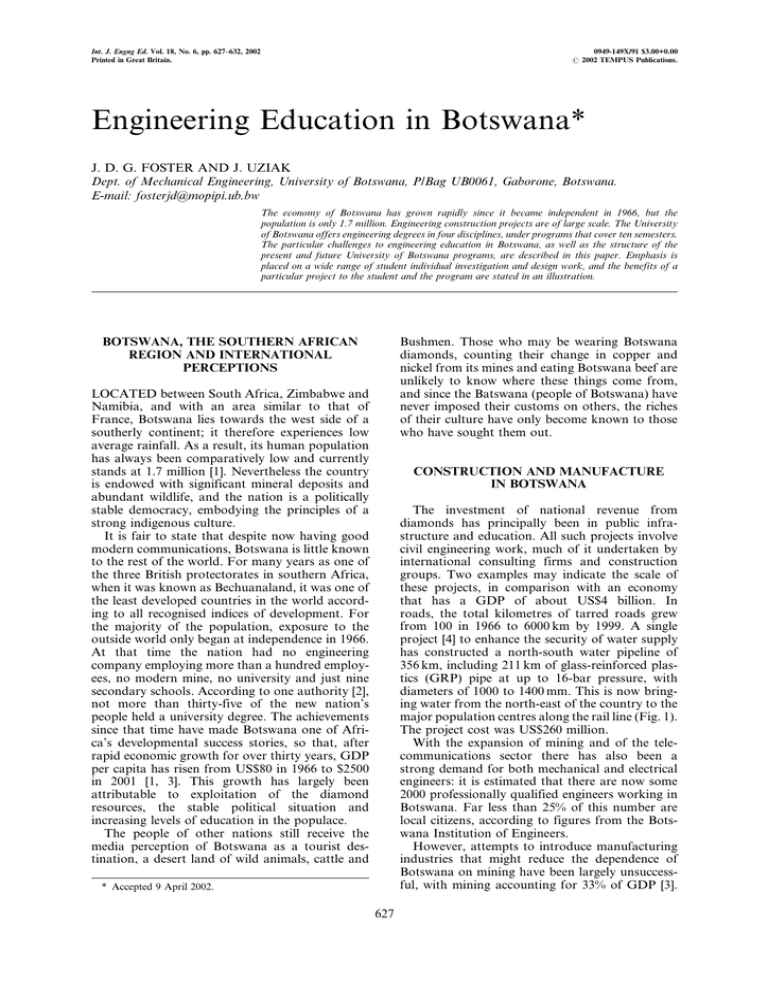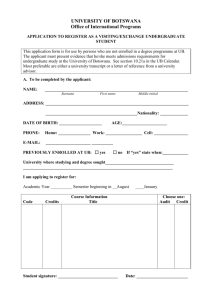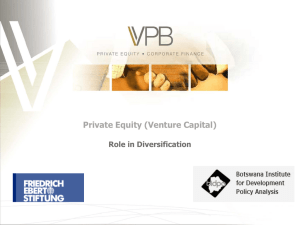Engineering Education in Botswana*
advertisement

Int. J. Engng Ed. Vol. 18, No. 6, pp. 627±632, 2002 Printed in Great Britain. 0949-149X/91 $3.00+0.00 # 2002 TEMPUS Publications. Engineering Education in Botswana* J. D. G. FOSTER AND J. UZIAK Dept. of Mechanical Engineering, University of Botswana, P/Bag UB0061, Gaborone, Botswana. E-mail: fosterjd@mopipi.ub.bw The economy of Botswana has grown rapidly since it became independent in 1966, but the population is only 1.7 million. Engineering construction projects are of large scale. The University of Botswana offers engineering degrees in four disciplines, under programs that cover ten semesters. The particular challenges to engineering education in Botswana, as well as the structure of the present and future University of Botswana programs, are described in this paper. Emphasis is placed on a wide range of student individual investigation and design work, and the benefits of a particular project to the student and the program are stated in an illustration. Bushmen. Those who may be wearing Botswana diamonds, counting their change in copper and nickel from its mines and eating Botswana beef are unlikely to know where these things come from, and since the Batswana (people of Botswana) have never imposed their customs on others, the riches of their culture have only become known to those who have sought them out. BOTSWANA, THE SOUTHERN AFRICAN REGION AND INTERNATIONAL PERCEPTIONS LOCATED between South Africa, Zimbabwe and Namibia, and with an area similar to that of France, Botswana lies towards the west side of a southerly continent; it therefore experiences low average rainfall. As a result, its human population has always been comparatively low and currently stands at 1.7 million [1]. Nevertheless the country is endowed with significant mineral deposits and abundant wildlife, and the nation is a politically stable democracy, embodying the principles of a strong indigenous culture. It is fair to state that despite now having good modern communications, Botswana is little known to the rest of the world. For many years as one of the three British protectorates in southern Africa, when it was known as Bechuanaland, it was one of the least developed countries in the world according to all recognised indices of development. For the majority of the population, exposure to the outside world only began at independence in 1966. At that time the nation had no engineering company employing more than a hundred employees, no modern mine, no university and just nine secondary schools. According to one authority [2], not more than thirty-five of the new nation's people held a university degree. The achievements since that time have made Botswana one of Africa's developmental success stories, so that, after rapid economic growth for over thirty years, GDP per capita has risen from US$80 in 1966 to $2500 in 2001 [1, 3]. This growth has largely been attributable to exploitation of the diamond resources, the stable political situation and increasing levels of education in the populace. The people of other nations still receive the media perception of Botswana as a tourist destination, a desert land of wild animals, cattle and CONSTRUCTION AND MANUFACTURE IN BOTSWANA The investment of national revenue from diamonds has principally been in public infrastructure and education. All such projects involve civil engineering work, much of it undertaken by international consulting firms and construction groups. Two examples may indicate the scale of these projects, in comparison with an economy that has a GDP of about US$4 billion. In roads, the total kilometres of tarred roads grew from 100 in 1966 to 6000 km by 1999. A single project [4] to enhance the security of water supply has constructed a north-south water pipeline of 356 km, including 211 km of glass-reinforced plastics (GRP) pipe at up to 16-bar pressure, with diameters of 1000 to 1400 mm. This is now bringing water from the north-east of the country to the major population centres along the rail line (Fig. 1). The project cost was US$260 million. With the expansion of mining and of the telecommunications sector there has also been a strong demand for both mechanical and electrical engineers: it is estimated that there are now some 2000 professionally qualified engineers working in Botswana. Far less than 25% of this number are local citizens, according to figures from the Botswana Institution of Engineers. However, attempts to introduce manufacturing industries that might reduce the dependence of Botswana on mining have been largely unsuccessful, with mining accounting for 33% of GDP [3]. * Accepted 9 April 2002. 627 628 J. Foster and J. Uziak Fig. 1. North-south water carrier. Major factors in this lack of success are the small size of the local market for manufactured goods, the lack of an appropriately skilled workforce and the closeness of established manufacturing centres in Gauteng and the rest of South Africa, with which Botswana shares a common customs area. Hence the employment of engineering graduates is dominated by civil engineering consultancy, building services engineering and public utilities, with only small numbers in process plants and factories. CHALLENGES AND AIMS OF ENGINEERING EDUCATION IN BOTSWANA The effective and efficient education of engineers in Botswana is considered by the Botswana Government as being of high priority. Recurrent costs per student place for engineering education at the University of Botswana (UB) were in 2001 some US$4000 (UB Financial Services figures), whereas to maintain the same student in the UK or USA would cost Botswana some US$28,000. The educators face many of the challenges that are internationally recognised in contemporary engineering education [5, 6]. Curricula are overloaded. Students may lose interest. Employers naturally expect to recruit graduates that are usefully skilled, confident and well motivated. However, the situation in Botswana has some special factors, which present their own challenges: 1. Even those few school leavers that select engineering as their career of first choice rarely have a home background that has exposed them to modern technology or the work of engineers. Generally only urban middle-income households have electricity, television, telephone or a home computer. 2. Graduates are unlikely to specialise in any particular facet of engineering (with the possible exception of maintenance engineering) and many will move into management positions early in their careers. 3. Qualified professionals in Botswana are recruited from many parts of the world and therefore all engineers are expected to work in multi-ethnic teams. Confidence and interpersonal skills are basic requirements for success. 4. In many workplaces, the engineer will be the only technically qualified person and will be expected to be the specifier, interpreter, advocate and judge of `foreign' technical solutions. 5. South Africa, as a large neighbouring country, exerts a strong influence. 6. Social and historical factors strongly discourage women from seeking careers in engineering [7]. All these factors argue for broadly based programs that must aim to give their students learning experiences that develop skills in: . . . . . practical construction communication techniques new technologies self-directed study environmental and social awareness. THE UNIVERSITY OF BOTSWANA Botswana has a single university located in Gaborone, the capital city, and with a centre for research in the Okavango inland delta at Maun (Fig. 1). It was established as a separate university in 1982, and offered no engineering courses until 1996: although the degree programs that are described here were taught by the then Botswana Polytechnic from 1990, with the degrees being awarded by the University. During the past ten years, the university has grown from a total enrolment of 3567 students (1991) to 11,485 (2001), and some of this growth was through the incorporation of the Botswana Polytechnic in 1996 [8, 9], establishing the Faculty of Engineering and Technology at the old polytechnic campus. Student numbers The Faculty of Engineering and Technology of the University of Botswana is very small by international standards. The student numbers for those who sat examination in the academic year 2000± 2001 are as shown in Table 1. Under the current development plan of the university [10] numbers are expected to grow to 600 students over 8 semesters in B.Eng., with up to 60 M.Eng. postgraduate students and with a further 665 non-engineering students also in the faculty taking programs in Design and Technology Education, Industrial Design, Mining, Architecture, Regional and Urban Planning. Engineering Education in Botswana Table 1. B.Eng. students by program 2000±2001 Civil Engineering (includes Year 2 and industrial internship) Building Engineering (Years 3 & 4) Electrical and Electronic Engineering Mechanical Engineering Foundation (all Engineering programs) 87 7 112 70 66 Total B.Eng. students (spread over nine semesters) 342 FUTURE DEVELOPMENT AND FACILITIES This paper describes the education of professional engineers for four branches of engineering in Botswana, and excludes consideration of education and training for craft-based trades and for technicians. In Botswana these groups are chiefly served by various government technical colleges and by private sector institutions, many of which receive government support. However, the University of Botswana has been providing the bulk of the technician training places since it merged with the former Botswana Polytechnic. Programs offered are not limited to engineering fields and include surveying, mining and general laboratory work. Plans for the further development of the Faculty of Engineering and Technology have recently been based on the assumption that the work of technician training will be taken over by the technical colleges, permitting the university to focus on programs leading to first degrees and postgraduate programs. These will cover Engineering, Architecture, Urban and Regional and Planning, Design and Technology Education and Industrial Design. The Faculty is to be relocated to a new site near the centre of the university, with a building of approximately 12 000 to 14 000 m2 that is being designed in accordance with a detailed brief prepared by the faculty itself [11, 12]. INDUSTRY INPUTS AND BENEFITS The academic teams delivering the programs have recognised from the start that the overall training of an engineer requires a combination of study and practice. Furthermore, they share a belief that meaningful industrial training provides considerable advantages if it is scheduled into the curriculum during the duration of studies. Industrial companies were therefore invited to provide training placements, initially as two separate semesters of the program. Academic staff assist companies in the setting of training objectives and do visit the students regularly during the industrial training periods. During this time the sponsor of the student pays both university fees and an enhanced student living allowance, so that there is no direct cost to the company providing the placement. Comments received from industrial companies, engineering consulting firms and other bodies 629 where placements take place indicate positive support for the scheme: employers consider that the scheme gives a competitive edge to University of Botswana graduates in comparison with those who have obtained engineering degrees in other countries. Some companies also make good use of the contacts developed with professors and lecturers during the company visits, providing motivation for consultancies and some research projects. Although companies primarily regard a university as a source of employable graduates, there is an increasing recognition that it also can be useful for information and technical expertise. Currently, the formal liaison between engineering practitioners and the university is through the advisory boards of the faculty and of its departments: the faculty advisory board comprises 11 practising engineers or representatives of public bodies together with 6 academic members. PRESENT CURRICULA AND THEIR HISTORY Botswana only reached the stage of being able to offer universal primary education to its children in the early 1980s, and it was not unusual to find young men of over 18 years who had earlier been kept from school to herd their fathers' cattle attending primary school with their young brothers and sisters. Partly as a result of this, the final examination in secondary school is the Botswana General Certificate of Education (BGCSE), which is normally taken by students when they are either 18 or 19 years old. Performance in this examination determines entry to the University of Botswana, and the normal time taken to reach the level of a first degree in Engineering (B.Eng.) from that point is five years (direct route) or six years (via ordinary diploma). Thus it is unusual to find a final year student who is younger than 23 years old. The present engineering degree structures, which have operated since 1990 [13], are to be transformed from year-on-year progression to a system with course credits by semester and grade point averages during 2002. There are presently four engineering programs, all leading to a B.Eng. degree: Building Engineering, Civil Engineering, Electrical/Electronic Engineering and Mechanical Engineering. All four programs commence with the first year (post GCSE/`O' Level) within the Faculty of Science, after which engineering students transfer to the Faculty of Engineering and Technology, where they follow a bridging course, the Engineering Foundation Course (EFC). After this one-semester course on engineering fundamentals the students then specialise by discipline in Years 2, 3 and 4. Between Years 2 and 3, and again between Years 3 and 4, they undergo Industrial Training (IT). Each period of IT is of 20-week duration. In the final 630 J. Foster and J. Uziak year each program offers two options to its students. NEW CURRICULA The new programs have been designed to give students greater choice from a wider range of courses, and to permit them to broaden their studies by taking courses offered by other faculties. The B.Eng. programs extend over ten semesters after entry at the GCSE level, or eight semesters for those with `A' level or Ordinary Diploma qualifications. Course credits over ten semesters are required to total 150, at approximately 15 per semester, of which 28 will be gained from general education or elective courses. Choices within the home faculty courses permit students to select among options for approximately 25% of the 122 credits attached to these courses. The general structure for a typical B.Eng. program is shown as Figure 2. Combined major programs, such as Civil Engineering and Economics, have also been enabled. Plans are in the final approval stages for selected graduate programs based on four-semester Master of Engineering (M.Eng.) degrees. The faculty also offers uncertificated short courses for professional development. LEARNING STRATEGIES The present culture of learning in Botswana owes a great deal to the requirements of the colonial and post-colonial civil service; it emphasises ranked and certified academic achievement. Students expect to be taught whatever set of facts will, once learnt, bring success. Young people in Botswana use the English word `study' in a sense that exclusively means `prepare for yearly examinations'. In this environment, innovative methods may often be treated with some scepticism. Nevertheless, students who have recognised Fig. 2. Structure of typical engineering program. the usefulness of an aspect of their studies do start to drive their own learning. Examples of this are found in CAD, multimedia presentation of project work and finite element analysis, which is introduced in the penultimate year. The University of Botswana has only recently taken the first steps in introducing techniques such as the sharing of course material, the use of multimedia and student facilities for web-based learning. However, for the engineering subjects, emphasis is placed in the later years of the programs on extended practicals, group projects and individual projects as the principal means of encouraging critical thinking, self-organisation and communication skills. THE ROLE OF STUDENT PROJECTS Evaluations by practising engineers and employers in Botswana [14] have emphasised the value that they place on skills that complement technical knowledge. The graduate engineer in Botswana, as in other countries, is expected to organise his/her own work, to dig out information relevant to the problem in hand, to communicate results, advocate changes and work in teams. It may be argued that all of these skills are particularly relevant in a developing country situation where many engineers work in comparative isolation from their peers and are frequently the only people in a company or other organisation that have the necessary background to acquire an in-depth knowledge of the technical aspects of a plant or other large infrastructural development. For this reason, the engineering curricula place progressively increasing emphasis on project or thesis work by students. All the disciplines at undergraduate level have a major project in the final year of studies in which the student will plan, research and present, both orally and in written form, an individual study. This is also the only part of the program for which one-on-one staff contact is expected on a regular basis. The types of project available and the topics offered are nevertheless flexible. All projects face budget constraints that the student must learn to manage, and projects that are directed towards solving local problems are favoured even if they are not expected to contribute to the state of the art internationally. The final year project in B.Eng. program of the University of Botswana is compulsory for all students. There are no formal lecture hours provided for this course although each student is supposed to work on the project for 4±6 hours per week. The project is done throughout the academic year, which consists of two semesters of 15-week duration. Apart from the project, the students have to follow four other subjects with approximately the same allocated time. The project evaluation is based on continuous assessment although it involves at least two presentations to a departmental panel. The first presentation, which Engineering Education in Botswana 631 Table 2. Typical B.Eng. projects Engineering (B.Eng.) Program Civil Civil Title Context Electrical/Electronic Mechanical Design of airport for light aircraft at Hukuntsi Stabilisation of low grade material (calcrete) used in desert road Causes of contractors' delays in construction projects Environmentally safe construction practices in Botswana Control loops for process modules using PLC and graphical PC interface High-speed Booth-encoded parallel multiplier Designing woman-friendly features into vehicles Mechanical Stress measurements in GRP pipe Mechanical Mechanical Program for kinematic analysis Mini baja buggy Mechanical Rural medical waste incinerator Construction Construction Electrical/Electronic is made in the middle of the first semester, is to present and approve the plan and time schedule for the project; the second and final presentation is made just before the end of the academic year. Both presentations are assessed by a panel and contribute to the final mark for the project. According to the 1990±2002 curricula, performance in the final year project may contribute up to 33% of the total credit for the final year. Under the new programs to be introduced in 2002, this proportion has been standardised for all engineering disciplines at 20% of the final year credits. Some recent projects To illustrate the range of student project work in various disciplines, Table 2 gives some titles together with comments on the context of the project. One project and its educational benefits The project listed as `program for kinematic analysis' in Table 2 may be taken as an illustration of the potential educational benefits of a dissertation project, not only to the students directly concerned, but also to their peers. The project was based on a well-known analysis of a four-bar linkage, and produced a program with graphical output that can include tabulations of velocities and acceleration, graphs of instantaneous values and an animation of the motion of the linkage. The important thing in this case was the fact that the program was written by a student of Mechanical Engineering with some limited help from his supervisor. It required from the student a full knowledge of analytical methods in the kinematic analysis of a four-bar linkage; the student achieved this through extensive literature review and discussions with the Desert location Significant research in association with government Department of Roads Shedding light on a topical debate The arid environment provides few pollution sinks Typical of several mine systems Study revealed that most affordably-priced vehicles marketed in Botswana fail to accommodate women's needs Relates to 350 km national strategic water pipeline See below Vehicle designed and built by four students and competed in international event at University of Pretoria Botswana contends with the highest level of HIV infection in the world. supervisor. He also became more conversant with computer programming, extending the skills he had acquired through his normal course in this area. These two points formed the aims of the project. The program that resulted is currently used as a teaching aid for students when they study the analysis of mechanisms or whenever there is a need to visualise the motion of a mechanism in a design assignment or project. There was a need for a user-friendly program of this nature for the reason that teaching aids are quite limited in developing countries. Mechanism analysis programs are frequently described in available literature, but they generally have to be treated by students as a ``black-box'', which they cannot access. This results in an impression that the work is something beyond their reach. It was a real experience both for the student and for the supervisor to go together through this learning process. CONCLUSION Botswana has an established need for engineering graduates. This paper has presented several special factors that are important in the design of engineering programs for Botswana. The aim of the University of Botswana is to continually develop its programs to keep up with the needs of engineers who will practice in Botswana. The experience of twelve years of running such programs has shown that they are cost-effective even at the present level of throughput, and that there is good reason to hope for further progress in the coming decades, as facilities are improved and intakes rise to meet demand. 632 J. Foster and J. Uziak REFERENCES 1. Botswana Government Ministry of Finance and Development Planning, Budget Speech, February 2002 2. S. Grant and J. Ramsay, One Botswana, One Nation: the arrival of independence, chapter 14 in The Birth of Botswana, ed. Fred Morton and Jeff Ramsay, pp. 187±194 Longman Botswana (1987). 3. Government of Botswana, Economic Snapshot, http://www.gov.bw/economy/index.html 4. First phase of Botswana's North-South Carrier now complete, Construction Review, May 2001, pp. 49±53. 5. R. A. Smith, Time for action: changing engineering education, in Innovative Teaching in Engineering, ed. R. A. Smith, pp. 21±26 Ellis Horwood London (1991). 6. J. Jawitz Facing the challenge of providing quality engineering education in Southern Africa, Proc. 2nd Southern African Conference on Engineering Education, pp. 1±4 Vaal Triangle Technikon (2000). 7. E. A. Baryeh, P. J. Squire and M. Mogotsi, Study of Female Engineering Students in Botswana, Proc. 2nd Southern African Conference on Engineering Education, pp. 21±26 Vaal Triangle Technikon (2000). 8. J. D. G. Foster and V. M. Mogwe, Incorporation of the Botswana Polytechnic into the University of Botswana; CAPA Bulawayo Colloquium; Commonwealth Association of Polytechnics in Africa (1996). 9. G. O. Anderson, Development of Faculty of Engineering and Technology, University of Botswana, FET'97 Seminar Technical Papers, pp. 84±89 (1997). 10. UBFET Background to Design Brief, 1999 (unpublished internal document) 11. J. Foster, M. T. Oladiran and J. Elliott, Planning a new engineering faculty building at the University of Botswana, Proc. 2nd Southern African Conference on Engineering Education, pp. 263±4 Vaal Triangle Technikon (2000). 12. University of Botswana FET, Design Brief for the Proposed Faculty of Engineering and Technology, November 2000. 13. T. J. Wilmshurst, Deserts, diamonds, diplomas and degrees, IEE Review, September 1994 14. B. Gubago, Of attitudes, confidence and communication in engineering curricula, FET'97 Seminar Technical Papers, pp. 23-32, ISBN 99912-0-229-3, University of Botswana (1997). John Foster is a Senior Lecturer in the Department of Mechanical Engineering of the University of Botswana. He teaches Applied Mechanics, Instrumentation and Control. Following a graduate apprenticeship at Lucas Electrical in Birmingham, he worked variously as a design engineer, commissioning engineer, workshop manager in both the U.K. and Botswana. He is actively involved in the proposals for establishing a Southern African Society of Engineering Educators. Jacek Uziak is a Senior Lecturer and Head of the Department of Mechanical Engineering of the University of Botswana. He specialises in the Theory of Machines and Mechanisms and teaches courses in this area. For the past 20 years he has been working at universities mainly in Poland and Botswana.








